RCC "Bramos"
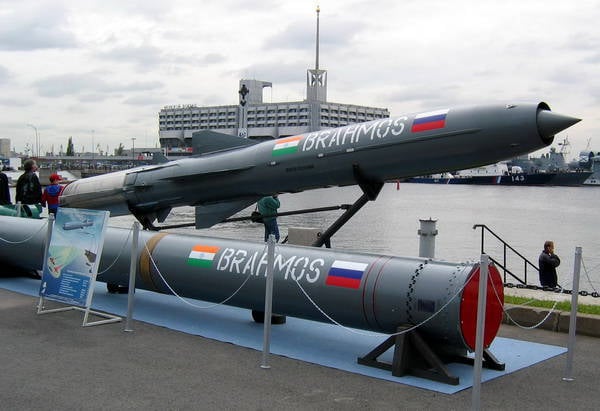
PJ-10 "BrahMos" is a supersonic cruise missile, which can be launched from submarines, surface ships, aircraft or land. It is a joint development of the Defense Research and Development Organization of India (DRDO) and the Russian NPO Mashinostroyenia, which in the 1998 year formed BrahMos Aerospace LLC (Ltd.). The fastest, in service, cruise missile in the world.
The designation "BrahMos" comes from the name of two rivers Brahmaputra in India and Moscow in Russia. The rocket is capable of a speed of 2,8-3,0 mach, which is 3,5 times the speed of a supersonic American cruise missile "Harpoon". The possibility of installing and launching the BrahMos from airplanes is currently being worked out, and it can be expected that by 2012, India will become a country with a supersonic cruise missile in all branches of the military. Moreover, an advanced model is being tested for quick air strikes that can reach speeds of 6M. The completion of the work is expected by 2016 year.
Although the Indian side expected that the BrahMos rocket would be built on the basis of the P-700 Granit medium-range cruise missile, the Russian specialists, taking into account the norms of the Missile Technology Control Regime, preferred the Onyx P-800 (export the name "Yakhont"). It is assumed that the total cost of development will be 13 billion. $.
History and development
Origin
PJ-10 BrahMos is a joint development of the Defense Research and Development Organization of India (DRDO) and the Russian NPO Mashinostroyenia, which in the year 1998 formed BrahMos Aerospace LLC (Ltd.). To participate in the project "NPO Mashinostroyenia", permission has been granted to carry out military-technical cooperation with foreign countries for 7 years. To create the rocket, the BrahMos Aerospace received 122,5 $ million from the Russian side and $ 128 million from the Indian side. One of the reasons for creating an association was the flexibility of Indian law, which exempts an enterprise that does not repay a loan from taxes. The latter allowed much more efficient to spend money.
The Russian side was involved in the production of the airframe and power plant, with many technologies that BrahMos Aerospace purchased from NPO Mashinostroeniya, and half of the details received from the Orenburg NPO Strela. The Indian specialists were given the task of finalizing the control systems and software.
The result of cooperation was the universal and fastest, in service, cruise missile in the world.
12 June 2001 of the year at the Chandipur state of Orissa carried out the first launch. Since the end of 2004, the rocket has undergone several tests on various launch platforms, including ground-based installations in the Pokhran desert, where it carried out an S-shaped maneuver at 2,8 mach speed. In the same place for the Indian army, the possibilities of attacking ground targets from the sea were shown.
In 2008, BraMos Corporation acquired the state-owned Indian company Keltec. About 15 billion rupees ($ 333 million) were invested in component development and integration of missile systems. This was necessary due to increased orders for the missile system, both from the Indian Army and fleet.
Indian naval forces became the main customer of the BrahMos missiles. It is expected that the PJ-10 will go to the armament of nuclear submarines and modern destroyers. Interest was also shown by the Indian Air Force, which sees a new missile in service with licensed Su-30MKI and IL-38.
Description
In fact, the entire BrahMos rocket is a power plant organically integrated into the glider. The control elements, the homing radar antenna and the warhead are located in the central cone of the fairing, while the remaining volume is occupied by the fuel for the cruise flight and the solid-fuel accelerating stage.
PJ-10 is capable of hitting ground targets at heights up to 10 meters. The maximum range of flight along the combined trajectory is 290 km, with low-altitude - 120 km. On the cruising stage, the maximum flight altitude reaches 14 km at a speed of 2,5-2,8M. The missiles of the ship complex have a combat unit with a mass of 200 kg, while a variant launched from a fighter ("BrahMos A") can carry a 300 kg warhead. PJ-10 is a two-stage rocket, it is equipped with a power plant with a solid starting and accelerating system and a hypersonic ramjet engine running on the march. Ramjet is more effective than rocket, because it increases the range.
High speed probably gives better penetration characteristics in comparison with light hypersonic rockets, for example, Tomogavk. Being twice as heavy and almost 4 times as fast as the Tomogawk, the PJ-10 has 32 times the kinetic energy (although it pays for it with a relatively short flight range and, having a total 3 / 5 payload, indicating a different tactical paradigm for two types of missiles).
The missile guidance and control systems include the inertial system and the CWGS. The radar homing head, created by the Russian Concern Granit-Electron OJSC, is similar to the Onyx SSN (Note: According to the information www.granit-electron.ru/products/mil/complex/yahont_head/). It is intended for searching, capturing and tracking targets in terms of RAP, selecting a target based on the entered data, receiving and transmitting the target coordinates to the on-board equipment control system (BASU) autopilot system. The GOS fixes the target and turns off, while the missile is reduced to 10 meters, which makes it difficult to detect it. the flight segment of the RGSN again Activate for targeting.
Despite the fact that initially the BrahMos was created as an anti-ship missile, it can be used against ground-based radio contrast objects. Depending on the complex, the launch is carried out vertically or in an inclined position. The rocket configuration is similar for sea, land and air platforms. The air-launched version ("BrahMos A") has a small starting engine, additional tail stabilizers and a modified nose fairing. The air-based complex weighs 2550 kg, which is 450 kg less than the ship-based or land-based complex. It intended to be used on the Su-30MKI (1-3 missiles on the pylons in the center of the fuselage and wings), Tu-142 (6 missiles on the wing suspensions), IL-76 (6 missiles on the wing pendants) and IL-38SD (4 missiles in the center of the airframe).
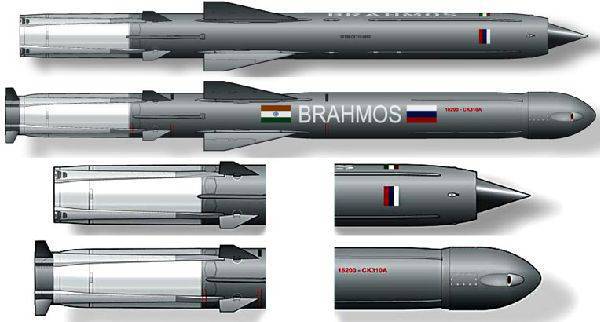
The figure shows the differences between the BrahMos (1 and 3 above) and BrahMos A
October 5 2005 of the year PJ-10 "BrahMos" set a record for the implementation of the first steep dive supersonic.
The options are:
Ship-based, anti-shipping
Ship-based, for firing at ground targets
Ground-based, for firing at ground targets
Ground-based, anti-shipping (tests 10 December 2010 of the year)
Airborne, anti-shipping (under development, expected to be completed in 2012 year)
Airborne, for firing at ground targets (in development, expected to be completed in 2012 year)
Underwater, anti-shipping (under development, expected to be completed in 2011 year)
Underwater-based, for firing at ground targets (in development, expected to be completed in 2011 year)
BrahMos 2 ground-based (development completed, the 4 variant was ready for testing in February 2011 of the year)
India and Russia will produce 10 BrahMos missiles in the next 1000 years, about 50% will be exported to friendly countries. This is probably beneficial for Russia, because India has a certain influence in Asia and is capable of supplying the missile to the arms market segments that are not accessible to Russia. For its armed forces, she ordered the BrahMos missiles worth $ 2 billion.
The Indian Navy has missile systems with transport-launch containers located obliquely or vertically, depending on the vessel. Talvar and Shivalik class frigates are armed with BrahMos missiles. In particular, Trishul (INS Trishul) and Tabar (INS Tabar) (the second and third Talvar frigates of the project, respectively) with a displacement of about 4000 tons are armed with 100-mm cannon, as well as anti-submarine missiles and eight container launchers with PKR "BrahMos" in the bow of the ship. In addition, each of them has two torpedo tubes of caliber 533-mm.
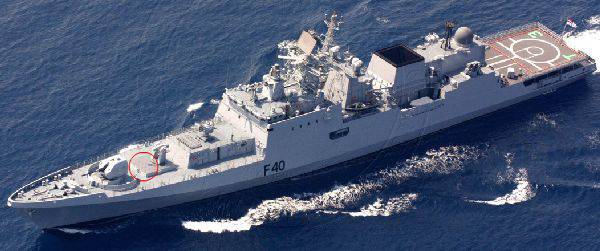
Frigate project "Talvar"
The frigate Shivalik (INS Shivalik) became the first frigate of the Shivalik class, armed with the BrahMos missiles. The displacement of this vessel is 6000 tons, it has two 30-mm cannon, 24 anti-aircraft missiles "Barak SAM" and 8 missiles PJ-10 "BrahMos".
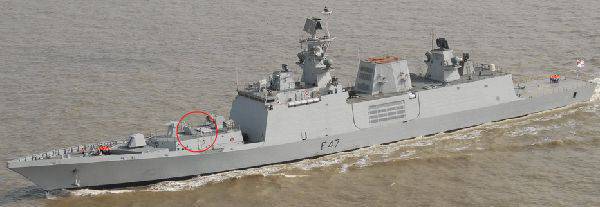
Frigate class "Shivalik". Indicated by the SCRC
With 2009-2010, Talvar and Shivalik class ships are armed with PJ-10 missiles. In the 2007, the year was also expected to equip new rockets of the Godavari and Brahmaputra frigates. Rajput (INS Rajput), Ranvir (INS Ranvir - D54) and Ranvija (INS Ranvijay - D55) missile destroyers, which are modern versions of the Soviet class Kashin destroyers, as well as Delhi-class destroyers received modern anti-ship missiles for 2009 year. 2012 is expected to equip Kolkata class destroyers with missiles.
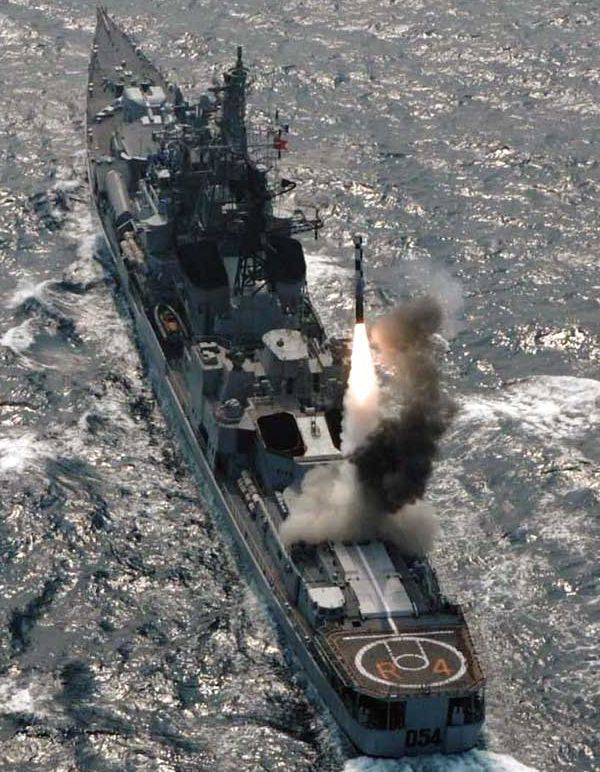
Destroyer class "Ranvir" launches missiles "BrahMos".
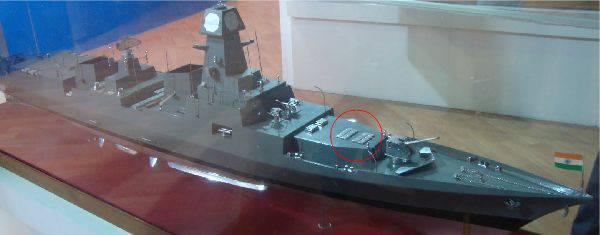
The destroyer class "Kolkata". Indicated launchers
The missile for launching from a submarine has already been developed and in the 2011 year must pass tests from a flooded stand located on a special pontoon. Indian submarines of the Kilo class can serve as the submarines for testing the PJ-10 BrahMos, or in Russia, the Lada-class non-nuclear submarines Amur-950. In 2005, the model of this submarine, created by CDB MT Rubin, was demonstrated at the BrahMos Aerospace stand in Abu Dhabi at the IDEX 2005 exposition. According to the layout, the missiles are placed in 10 vertical launchers, which allow immediate launch on land and sea targets.
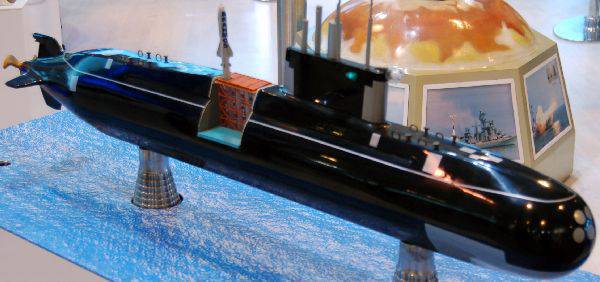
Layout of the Amur-950 submarine with the BrahMos anti-ship missile.
BrahMos 1 1 ground-to-ground block
Land-based model for the Indian Army.
The rocket was successfully tested in the desert of Rajasthan, located near Pokhran (December 2004 and March 2007 year). 21 June 2007 of the year entered service.
BrahMos 1 2 Block
In January, 2009, the new model 2 unit with new software was tested in Pokhran. The rocket failed to hit the right target among the group. The target was a small structure among other buildings. However, already in 4 March, good results were obtained. The latest tests conducted by 29 March 2009 of the year were successful. For 2,5 minutes a rocket hit the target with high accuracy. According to official sources, "The new homing head is unique and has provided a defeat for the building, which was slightly different in size from other buildings."
5 September 2010 passed the BrahMos missiles off the coast of Orissa and set a world record. The first case was recorded when a rocket with a supersonic speed made a steep dive. The launch took place from the -3 (LC-3) missile system near Chandipur in 11: 35. These tests fully satisfied the requirements of the land army of India in the new software for the RGSN, which provides the missile with the ability to recognize and select among a group of targets, delivering high-precision strikes.
The Indian Army formed a regiment (no. 861) "BrahMos" Mark 1. Now there are two separate BrahMos regiments Mark 2 (862 and 863), the missiles in service with which are GOS, capable of carrying out the selection of small targets among urban buildings. Each of the two rocket regiments will have 4-6 batteries from 3-4 mobile launchers mounted on all-wheel-drive Tatra trucks from Czech production.
BrahMos 1 3 Block
It is an improved version of a hypersonic rocket, which successfully passed 2 December 2010, at the ITR (Integrated Test Range) test site, Chandipur, the coast of Orissa.
"BrahMos" 1 The 3 unit with the new navigation and control software, combined with high maneuverability and steep dive capability, was launched from the PU-3.
Indian Air Force
Air-launched missiles are ready for testing. The DRDO Committee and the Air Force are prohibited from making any modifications with the Su-30MKI fighter, therefore 10 January 2009, the 2 aircraft were sent to Russia to conduct a suspension training program and launch systems.
In May, the 2010 of the year was approved by the 40 fighter upgrade program. Su-30MKI, in addition to the adaptation of the BrahMos anti-ship missiles, will receive a new on-board computer, radar and electronic combat systems. A pair of Indian aircraft during the 2011-2012 period of the year will be upgraded in Russia, and starting from 2015, HAL will be engaged in this work.
Currently, Russian and Indian engineers are working on the adaptation of the RCC. It was possible to get a lightweight version of the rocket with a length of 8,3 meter, a diameter of 0,67 meter and a mass of 2550 kg.
In service with Russia
Since the BrahMos is structurally similar to the P-800 Onyx missiles, it can replace them as part of the missile system, in particular, on the 22350 frigates. The Navy did not enter service.
Export
Currently, the export of missiles is not carried out, despite the fact that interest was shown by South Africa, Egypt, Oman, Brunei. In February 2010, it was reported that India was negotiating the sale of missiles to Chile, Brazil, South Africa and Indonesia. Malaysia is also interested in PKR for arming its Kedah class ships.
Brahmos 2
At a press conference called Brahmos, which took place on 19 on August 2008 in Moscow, the head of the Russian-Indian joint venture BrahMos Aerospace, Sivathanu Pillai, proposed creating a hypersonic anti-ship missile based on the existing missile that would develop the 6M speed.
The initiative proposal of the Indian side with the skepticism of the Russian partners was reinforced by the presentation titled "The scramjet combustion chamber was tested for a hypersonic rocket." The slides showed model engines of two types - kerosene and hydrogen fuel. The scramjet specimens had dimensions 85x40 mm in cross section. According to the data obtained, supersonic combustion in the CS at a speed of about 2,2M, in modes that correspond to the conditions of flight with Mach numbers near 6,5 at altitudes up to 30-35 km. The data were similar to those reported for the promising program "Tool for the Demonstration of Hypersonic Technology" or HSTDV ["Takeoff", No.11-2008, "Hypersound over the Ganges"]. It is worth noting that India has long been interested in creating a hypersonic cruise missile that can reach speeds up to M = 6,5 at an altitude of 32,5 km, for which it is developing equipment for ground and flight tests.
Currently, the Brahmos 2 RCC is being designed, the declared speed of which will be 5,26 M. Four new missile projects are already ready, and the final version will be approved in October 2011 of the year, and launches will take place in 2012-2013. RCC will go into service with destroyers of the project 15B in India. The Russian fleet is likely to receive the Brahmos 2 for destroyers of the 21956 project.
Performance characteristics:
Developer: BrahMos Aerospace
Designation: PJ-10 "BrahMos"
First start: 12 2001 June
Length m: 8
Wingspan, m: 1,7
Diameter, m: 0,7
Starting weight, kg: 3000
Marching Engine: SPVRD
Thrust, kgf (kN): 4000
Start-up stage: solid fuel
Speed, m / s (M =) at the height: 750 (2,5-2,8)
Speed, m / s (M =) at the ground: (2)
Starting range, km
-by combined trajectory: to 300
- by low-altitude trajectory: to 120
-on the march area: 14000 m
Flight height, m:
-on the low-altitude trajectory: 10-15
the goal: 5-15
Control system: autonomous with inertial navigation system and RGSN
Warhead type: piercing
Weight, kg: to 300
The slope of the launcher, degrees: 0-90
Information